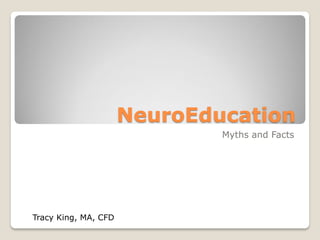
NeuroEducation: Myths and Facts
- 1. NeuroEducation Myths and Facts Tracy King, MA, CFD
- 2. How do you know what you know?
- 3. How do you know what you know?
- 4. How do you know what you know?
- 6. Players
- 7. Key Points NeuroMyths / NeuroFacts / NeuroFuture
- 8. Your Turn Pick a partner Table talk topics: ◦ Introduce your self & where you are from ◦ Identify which of the main points is most interesting to you and your work 2 minutes
- 9. NeuroMyths Myth 1: We only use 10% of our brains
- 10. NeuroMyths Myth 2: The brain’s structure & potential is determined by age 3 Photo credit: Flickr / Hopefuldz9er
- 11. NeuroMyths Myth 3: We are capable of multitasking
- 12. Your Turn Pick a partner Table talk topics: ◦ Which additional Neuromyths do you know about? ◦ What approaches might you use to address myths in course design? 3 minutes
- 13. NeuroFacts: Stress Fact: Learning is enhanced by challenge and inhibited by threat. Photo credit: Flickr / Rebecca-Lee • If a learner feels threatened or unsafe (whether physically or emotionally), the stress response inhibits learning. • If a learner feels challenged, relaxed and alert – they are primed for learning.
- 14. NeuroFacts: Attention Photo credit: Flickr / Capt. Tim Fact: Attention sharpens focus – what the learner focuses upon is encoded. • Attention is the cognitive process that determines what to focus upon and what to ignore. • Attention hooks • Emotional appeal • Novel stimuli • Personal relevance • Hands on experience • Patterns
- 15. NeuroFacts: Model Building Fact: Learning is a constructivist process – we scaffold new concepts onto existing models. Photo credit: Flickr / atsitra • Knowledge structures in the brain relate new information to what is known. • Assessment is key to discovering misconceptions and customizing new learning.
- 16. NeuroFacts: Repetition Fact: What’s repeated is remembered. Photo credit: Flickr / dkilim • Repeated access and application of new learning forms physical pathways in the brain improving retrieval and recall. • Spaced learning vs. massed learning • Deliberate practice leads to mastery.
- 17. NeuroFacts: Visual Bias Fact: Pictorial superiority effect (PSE) is a reality – not a learning style. Photo credit: Flickr / doobybrain • The more visual the input, the more reliable the retrieval. • The brain easily stores images; text is processed both as images (letter forms) and interpreted semantically requiring a complex encoding process.
- 18. NeuroFacts: Reflection Fact: Reflection is required for long term integration of concepts. Photo credit: Flickr / gfpeck • Reflection moves info from the sensory brain to the integrative brain center. • The reflective brain searches for connections and deepens comprehension. • Reflection is required for developing complex thinking and understanding. • Reflection takes time!
- 19. NeuroFacts Stress (challenge vs. threat) Attention (attention long-term memory) Model Building (scaffold learning) Repetition (well used pathways) Visual Bias (we remember images) Reflection (activating the integrative brain)
- 20. Your Turn Table discussion Table talk topics: ◦ Which of these Neurofacts has the greatest impact on your work? ◦ How can you seize this as an opportunity in course design? 5 minutes
- 21. NeuroFuture: Disruptive Tech Photo credit: Flickr / HawkinsSteven
- 22. Thank You! Twitter: @TracyInspired LinkedIn: www.linkedin.com/in/tracylking Scoopit: www.scoop.it/t/aligned-design
- 23. Resources Clark, Ruth Clovin; Mayer, Richard E. (2008) e-Learning and the Science of Instruction: Proven guidelines for consumers and designers of multimedia learning, Second Ed. Pfeiffer: San Francisco, CA. Ericsson, K Anders, et al, (1993) The Role of Deliberate Practice in the Acquisition of Expert Performance. Psychological Review 100:3. http://graphics8.nytimes.com/images/blogs/freakonomics/pdf/Delibe ratePractice(PsychologicalReview).pdf Deckker, Sanne; Lee, Nikki; Howard-Jones, Paul; Jolles, Jelle. (2012) Neuromyths in education: Prevalence of predictors of misconceptions among teachers. Frontiers in Educational Psychology. http://www.frontiersin.org/Educational_Psychology/10.3389/fpsyg.20 12.00429/full Medina, John. (2008) Brain Rules: 12 Principles for Surviving and Thriving at Work, Home and School. Pear Press: Seattle Washington. Sousa, David, A., ED. (2010) Mind, Brain, & Education: Neuroscience Implications for the Classroom. Solution Tree Press: Bloomington, IN.
- 24. Resources Tokuhama-Espinosa, Tracey, PhD. (2011) Mind, Brain and Education Science: A Comprehensive Guide to the New Brain-Based Teaching. WW Norton & Company, Inc.: New York. Zull, James E. (2002) The Art of Changing the Brain: Enriching the practice of teaching by exploring the biology of learning. Stylus Publishing, LLC: Sterling, VA. Zull, James E. (2011) From Brain to Mind: Using Neuroscience to Guide Change in Education. Stylus Publishing, LLC: Sterling, VA. Links Brain Rules: http://www.brainrules.net/ Learning Landscapes Journal, Autumn 2011: http://www.learninglandscapes.ca/images/documents/ll-no9-final-lr- 2.pdf OECD Report: Understanding the Brain: The Birth of a Learning Science: http://www.oecd.org/site/educeri21st/40554190.pdf Tracey Tokuhama-Espinoza book excerpt: http://education.jhu.edu/PD/newhorizons/Journals/Winter2011/Tokuh ama1
- 25. Resources Organizations Centre for Educational Neuroscience: http://cen.squarevale.com/wordpress/ Dana Foundation: http://www.dana.org/neuroeducation/ Johns Hopkins Neuro Education Initiative: http://education.jhu.edu/research/nei/ Society for Neuroscience: www.sfn.org
- 26. Brain Facts The average human brain weighs about 3 lbs & is the size of a medium head of cauliflower 20% of your energy is dedicated to maintaining your brain Your brain is comprised of 100 billion neurons – the same number of stars in the known universe The energy used by the brain is enough to power a 25 watt bulb! There are no pain receptors in the brain The old adage we only use 10% of our brains is not true. There is a known function for each part of the brain Neurons are social and make an average of 10,000 connections (synapses) – take that Facebook! Laughing requires activity in 5 different areas of the brain http://www.nursingassistantcentral.com/blog/2008/100-fascinating-facts-you-never-knew-about-the-human-brain/ Photo credit: Shutterstock
Notes de l'éditeur
- One thought and the conclusion
